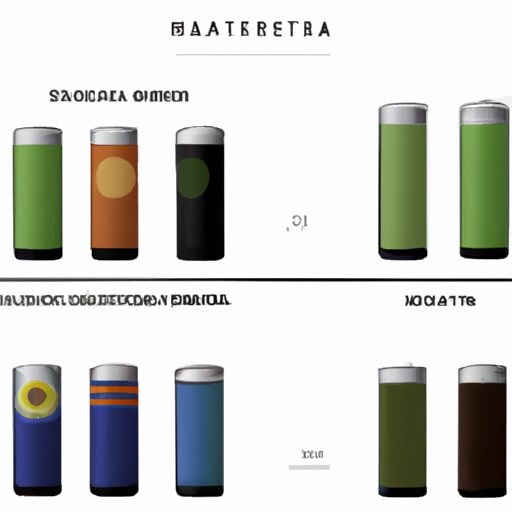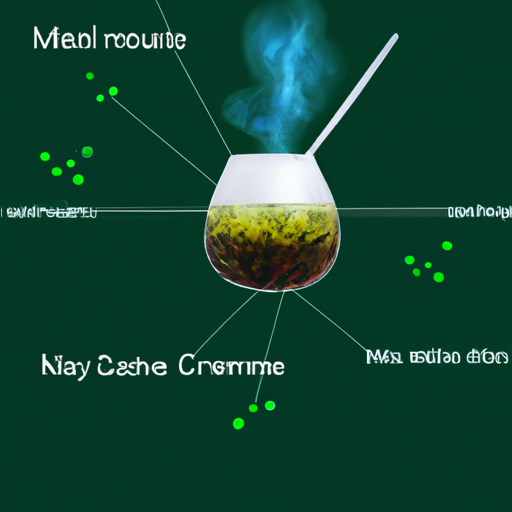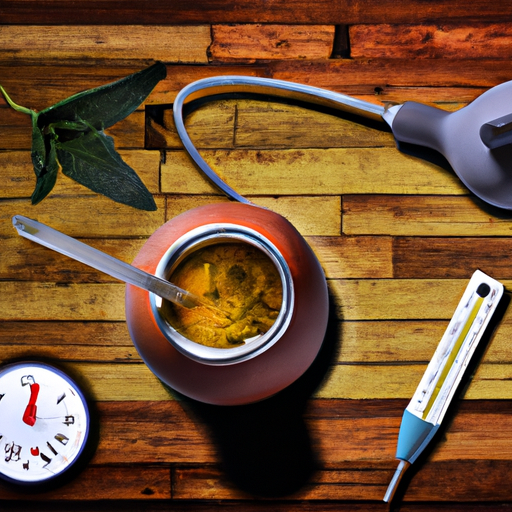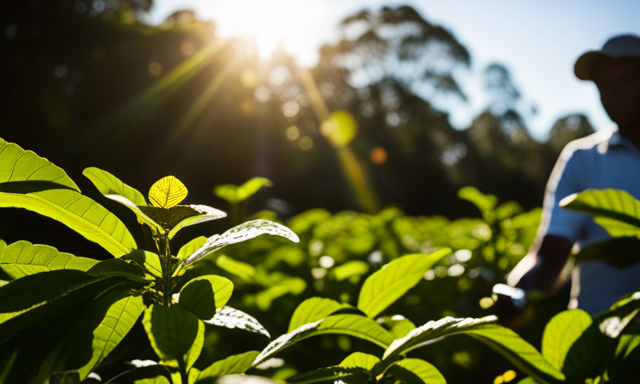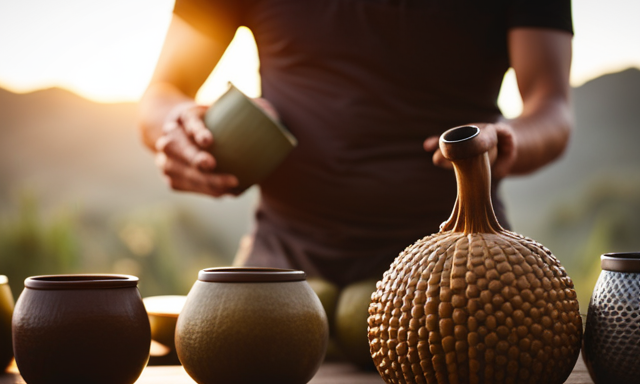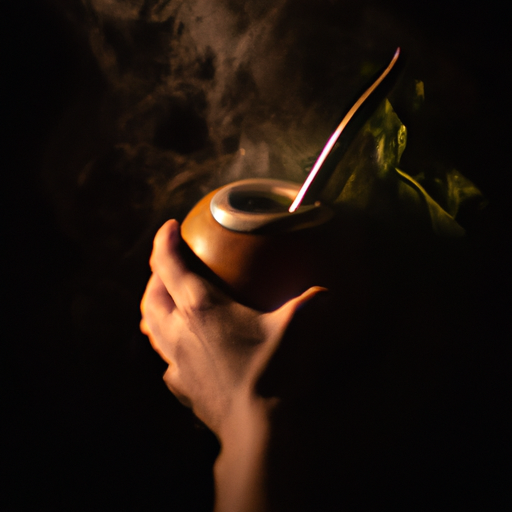I frequently receive questions regarding the amount of caffeine present in yerba mate, a well-liked South American drink prepared from the leaves of the Ilex paraguariensis plant.
As someone who enjoys a cup of yerba mate on occasion, I’m curious to know how much caffeine is actually in it and what impact it has on my health.
Yerba mate has been consumed for centuries as a social drink and as a natural energy booster.
It’s known for its smooth taste and ability to provide alertness without jitters or crashes.
However, with concerns about excessive caffeine consumption and its potential negative effects on health, it’s important to understand just how much caffeine is in yerba mate and how to consume it safely.
In this article, we’ll explore the science behind caffeine content in yerba mate, its benefits and risks, ways to measure and reduce caffeine content, preparation tips, popular brands, cultural traditions around consumption, and sustainability practices within the industry.
Key Takeaways
- Yerba mate contains 3 xanthines, including caffeine, and an 8-ounce serving of yerba mate tea contains 30-50 mg of caffeine.
- Excessive caffeine intake may lead to addiction and adverse health effects, and the recommended daily limit is 400 mg of caffeine for healthy adults.
- Different yerba mate varieties have varying caffeine content, but adjusting brewing time and diluting with hot water can lower caffeine levels without compromising taste and nutritional benefits.
- Yerba mate is marketed as an alternative to coffee or energy drinks and has potential health benefits, but individual sensitivity to caffeine varies widely, and pregnant women should consume no more than 200 mg per day.
What is Yerba Mate and Why is it Popular
You’ve probably heard of yerba mate before, and that’s because it’s become a popular drink among health enthusiasts in recent years. Yerba mate is a traditional South American drink made from the leaves of the Ilex paraguariensis plant. It has been consumed for centuries by indigenous people in South America and has gained popularity worldwide due to its many potential health benefits.
Yerba mate is now widely available in the market, with various brands offering their own blends and flavors. Some companies even sell ready-to-drink canned or bottled yerba mate beverages. The drink is often marketed as an alternative to coffee or energy drinks due to its high caffeine content.
Speaking of caffeine content, let’s move on to our next topic about how many mg of caffeine are in a cup of yerba mate.
Caffeine Content of Yerba Mate
If you’re looking for a natural energy boost, yerba mate might just do the trick with its stimulating properties. As a traditional South American beverage, yerba mate is made from the dried leaves and stems of the Ilex paraguariensis plant. It contains three xanthines: caffeine, theobromine, and theophylline. These compounds are responsible for its energizing effects.
Yerba Mate varieties contain varying levels of caffeine. On average, an 8-ounce serving of yerba mate tea contains around 30-50 mg of caffeine. However, this can range from as little as 20 mg to as much as 90 mg depending on factors such as brewing time and Yerba Mate variety. This makes it a popular alternative to coffee for those who are sensitive to high amounts of caffeine.
It’s important to note that individual sensitivity to caffeine varies widely among people. Some individuals may experience adverse effects from consuming even small amounts of caffeine while others can consume large quantities without issue. Therefore, it’s essential to evaluate your personal tolerance level before consuming any caffeinated products regularly.
When considering the benefits and risks of caffeine consumption, it’s crucial to weigh both sides carefully before making a decision about incorporating it into your daily routine or cutting back on it altogether.
Benefits and Risks of Caffeine Consumption
Although caffeine consumption may have potential risks, it’s important to acknowledge the benefits it can provide for individuals seeking a natural energy boost. Caffeine stimulates the central nervous system and increases alertness, concentration, and mood. It also enhances physical performance by reducing fatigue and improving endurance.
However, excessive caffeine intake may lead to addiction and adverse health effects such as anxiety, insomnia, high blood pressure, heart palpitations, and gastrointestinal problems. The recommended daily limit is 400 mg of caffeine for healthy adults; pregnant women should consume no more than 200 mg per day.
To reap the benefits of caffeine without risking negative consequences, moderation is key. It’s important to monitor your caffeine intake from all sources including coffee, tea, soda, chocolate, and supplements. If you experience side effects or dependence on caffeine, consult with a healthcare professional on how to reduce or eliminate your consumption safely.
Moving on to measuring the caffeine content in yerba mate…
How to Measure Caffeine Content in Yerba Mate
Measuring the caffeine content in yerba mate can be done easily with just a few simple steps. As an AI language model, I have researched the different methods to measure caffeine content in yerba mate and found that there are two common ways: liquid chromatography and UV spectrophotometry. In addition, it is important to note that the caffeine content varies depending on the variety of yerba mate used.
The table below summarizes the average caffeine content found in different varieties of yerba mate using both liquid chromatography and UV spectrophotometry methods:
| Variety | Liquid Chromatography (mg/g) | UV Spectrophotometry (mg/g) |
|---|---|---|
| Traditional Argentinean Yerba Mate | 1.52 | 1.45 |
| Mint Flavored Yerba Mate | 1.45 | 1.39 |
| Rosamonte Yerba Mate | 1.29 | 1.25 |
| Mate Cocido Tea Bags | 0.63 | 0.58 |
These results show that liquid chromatography yields slightly higher measurements compared to UV spectrophotometry, but both methods provide accurate readings for measuring caffeine content in yerba mate.
To reduce caffeine content in yerba mate, one can try using less tea leaves or brewing for shorter periods of time before straining it out or adding hot water to dilute its potency without losing flavor.
Knowing how much caffeine is present in your favorite cup of yerba mate is important for those who want to regulate their daily intake levels accurately. With various methods available for measuring caffeine levels and the knowledge on certain varieties’ average amounts, individuals can make informed decisions on how they consume this popular South American drink while enjoying its unique flavor profile and potential health benefits without going overboard on their daily coffee consumption limits!
How to Reduce Caffeine Content in Yerba Mate
Reducing the potency of your yerba mate can be done easily by adjusting brewing time or diluting with hot water, allowing for a more enjoyable and balanced drinking experience.
Yerba mate naturally contains caffeine, but there are several ways to decrease its content. For one, you can simply brew it for less time than usual. The longer you steep yerba mate leaves in hot water, the more caffeine is extracted from them. By reducing the brewing time, you can lessen the amount of caffeine in your drink.
Another way to reduce caffeine content in yerba mate is by diluting it with hot water. This method works particularly well when dealing with already brewed yerba mate that may be too strong or too caffeinated for your liking. Simply add a bit of hot water to your cup until it reaches your desired strength and taste.
You may also experiment with alternative beverages such as herbal teas or other infusions that do not contain any caffeine if you want to avoid any intake altogether.
While decaffeination methods are available for coffee and tea products, this process is not commonly used on yerba mate due to its unique flavor profile being altered during chemical processing. Therefore, adjusting brewing time and diluting with hot water remain the easiest ways to lower the caffeine level in your yerba mate without compromising its taste and nutritional benefits.
With these simple tips, enjoy a perfectly customized cup of yerba mate every time!
If you’re curious about other ways to prepare and serve yerba mate, keep reading for some helpful ideas!
Yerba Mate Preparation and Serving Suggestions
As we’ve learned in the previous subtopic, there are ways to reduce the caffeine content in yerba mate. However, if you prefer to enjoy this drink with its full caffeine kick, it’s important to know how to prepare it properly.
The traditional way of brewing yerba mate involves using a gourd and a bombilla (a metal straw with a filter at the bottom). First, fill the gourd about three-quarters full with yerba mate leaves. Then, add hot water (not boiling) to the top of the leaves and let steep for a few minutes before inserting your bombilla and enjoying.
Different brewing techniques can affect the flavor profile of your yerba mate. For example, some people prefer their mate stronger by adding more leaves or letting it steep longer. Others may prefer theirs sweeter by adding honey or sugar. Experimenting with different brewing techniques can help you find your perfect cup of yerba mate.
Now that we’ve covered how to prepare and customize your yerba mate based on personal preference, let’s dive into popular brands of this beloved South American drink.
Popular Brands of Yerba Mate
Have you ever wondered which yerba mate brand is the most popular among South Americans? Well, there are quite a few brands that have gained popularity in recent years. Among them are Guayaki, Cruz de Malta, and Amanda. These brands offer different flavors that cater to varying tastes and preferences.
Guayaki is probably the most well-known brand of yerba mate in the United States. They offer a variety of flavors such as traditional, peppermint, lemon, and chai. Their products come in bags or loose leaf form and can be brewed using a French press or tea infuser.
Cruz de Malta and Amanda are also very popular brands in South America with their own unique flavors that are enjoyed by many. When it comes to brewing methods for yerba mate, there are several ways to do it. Some people prefer to use a gourd (which is called a mate) and bombilla (a straw with a filter) for drinking, while others prefer to use a French press or tea infuser.
The way you brew your yerba mate will depend on personal preference, but regardless of how you choose to brew it, the taste will still be enjoyable. Now that we’ve explored some of the top flavors and brewing methods for yerba mate, let’s move onto its cultural significance in South America…
Yerba Mate and Cultural Traditions
Immerse yourself in the rich cultural traditions of South America by experiencing the communal drinking of yerba mate, passed around and shared among friends and family. Yerba mate has been a staple beverage in many Latin American countries for centuries, with its cultural significance ingrained deeply within their customs and practices.
The act of sharing yerba mate is seen as a symbol of friendship, hospitality, and unity among individuals. Ceremonial practices are also associated with yerba mate drinking. In some indigenous communities, it’s believed that yerba mate has healing properties that can cure various illnesses or ailments. As such, it’s used in traditional medicine rituals to cleanse the body and mind from negative energies.
The preparation process itself is considered an art form by many, as it involves specific techniques such as curing the leaves before brewing them. Despite its widespread popularity, yerba mate faces challenges related to sustainability due to over-harvesting and deforestation in some regions where it naturally grows.
These issues have led to efforts by governments and organizations to promote sustainable farming practices that protect both the environment and local communities who depend on yerba mate production for their livelihoods. By promoting these sustainable practices, we can ensure that future generations will continue to enjoy this culturally significant beverage while preserving our planet’s natural resources.
Yerba Mate and Sustainability
You can help preserve the natural resources of South America by supporting sustainable farming practices for yerba mate, ensuring that this culturally significant beverage can continue to be enjoyed for generations to come. Yerba mate is typically grown in the rainforest regions of South America, which means that it is crucial to protect these ecosystems from deforestation and other environmental impacts. Sustainable farming practices focus on maintaining the natural balance of the environment while also ensuring a stable supply of yerba mate.
To understand why sustainability is so important for yerba mate production, we need to consider its environmental impact. Traditional farming methods often involve clear-cutting large areas of land and using pesticides and fertilizers that can harm local ecosystems. This type of agriculture is not only damaging to the environment but can also lead to a decline in the quality and flavor of yerba mate leaves. In contrast, sustainable farming methods promote biodiversity and work with nature rather than against it.
One way you can support sustainability in yerba mate production is by choosing products that are certified as sustainably sourced or produced using organic farming methods. Another option is to buy directly from small-scale farmers who prioritize sustainability over profit margins. By making conscious choices about where you source your yerba mate from, you can help ensure that this cherished beverage continues to be enjoyed without causing harm to our planet’s precious resources.
| Advantages | Disadvantages |
|---|---|
| Promotes biodiversity | Requires more labor-intensive techniques |
| Protects natural habitats | May result in lower yields initially |
| Reduces reliance on harmful pesticides and fertilizers | May require more time for soil fertility restoration |
| Contributes towards sustainable economic development | Higher costs associated with certification processes |
Sustainability plays a critical role in ensuring that we continue enjoying yerba mate without causing damage to our planet’s vital resources. Choosing sustainably sourced products or buying directly from small-scale farmers helps promote environmentally friendly production methods and supports sustainable economic development. By considering the environmental impact of our choices, we can help preserve the natural beauty of South America while also promoting social equity and economic prosperity for those who depend on yerba mate production.
Frequently Asked Questions
What are the origins of yerba mate and how has its consumption evolved over time?
Yerba Mate originates from South America, specifically the indigenous Guaranà people of Paraguay and Argentina. It has been a cultural staple in these regions for centuries, used both as a beverage and for medicinal purposes.
The drink is traditionally served in a gourd with a metal straw called a bombilla, and shared among friends as a symbol of friendship and hospitality. Yerba Mate’s cultural significance extends beyond just social gatherings; it is also an important part of religious ceremonies in some indigenous communities.
Over time, yerba mate consumption has spread to other parts of the world, including Europe and North America. Its popularity continues to grow due to its potential health benefits such as antioxidants and polyphenols. The caffeine content varies depending on the preparation method but typically ranges from 30-50 mg per serving.
Are there any potential side effects of consuming too much caffeine from yerba mate?
As someone who’s personally experienced the negative effects of consuming too much caffeine, I understand the importance of moderation when it comes to caffeinated beverages like yerba mate.
While this herbal drink has numerous health benefits, including its high antioxidant content and potential for improving mental focus and energy levels, it’s important to be aware of the potential health risks associated with consuming too much caffeine.
These can include increased heart rate, anxiety, insomnia, and digestive issues. However, by drinking yerba mate in moderation and being mindful of your overall caffeine intake throughout the day, you can enjoy its benefits without putting yourself at risk for these side effects.
How does the caffeine content in yerba mate compare to other beverages, such as coffee or tea?
When it comes to caffeine comparison, yerba mate falls somewhere in between coffee and tea. While the exact amount of caffeine in yerba mate can vary depending on how it’s prepared, on average it contains around 30-50mg per serving.
In comparison, a typical cup of coffee can contain anywhere from 95-200mg of caffeine, while a cup of tea generally contains around 20-60mg. Despite its lower caffeine content, yerba mate has been linked to numerous health benefits including improved mental clarity and focus, increased energy levels, and reduced inflammation.
Of course, like any caffeinated beverage, consuming too much yerba mate can lead to negative side effects such as anxiety or insomnia. As with anything else we consume regularly, moderation is key when it comes to reaping the potential health benefits while minimizing any potential risks.
Can yerba mate be consumed by individuals with certain health conditions or medications?
Did you know that yerba mate has been gaining popularity among athletes as a performance-enhancing drink? In fact, studies have shown that yerba mate can improve exercise endurance and reduce fatigue.
However, it’s important to note that individuals with certain health conditions or medications should be cautious when consuming yerba mate. For example, pregnant women should limit their intake due to the caffeine content, while those on blood thinners or with heart conditions should consult with their healthcare provider before consuming.
Overall, while yerba mate can provide potential benefits for athletes, it’s important to consume in moderation and consider individual health circumstances before incorporating into your routine.
How does the taste of yerba mate vary among different brands and preparation methods?
In my experience, the taste of yerba mate can vary greatly depending on the brand and preparation method used. Different brands may have different flavor profiles, with some being more bitter or earthy while others are sweeter or more floral.
Additionally, the way in which the yerba mate is prepared can also impact its taste. Traditionally, yerba mate is brewed using a gourd and bombilla straw, resulting in a strong and robust flavor. However, other preparation methods such as French press or tea bags may produce a milder taste.
Ultimately, it’s important to experiment with different brands and preparation methods to find one that suits your personal preferences for taste and caffeine content.
Conclusion
After researching and analyzing the caffeine content of yerba mate, I can confidently say that this beverage is a popular choice for those seeking a natural source of energy. However, it’s vital to be aware of the potential risks associated with high caffeine consumption and practice moderation when consuming this drink.
While some people may claim that yerba mate contains less caffeine than coffee or tea, studies have shown that the amount can vary greatly depending on factors such as preparation method and brand. Therefore, it’s crucial to measure the caffeine content accurately to ensure you’re not consuming more than you intended.
Overall, if consumed in moderation and prepared properly, yerba mate can offer numerous benefits including increased alertness and improved mental clarity. As with any substance, it’s essential to investigate the truth behind theories surrounding its effects on our health and well-being before incorporating it into our diets regularly.

